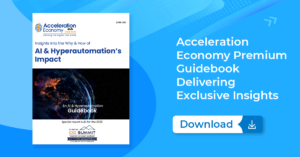The pressure has been rising for healthcare systems to handle data from an expanding array of internal and external sources more quickly and accurately. At the same time, an already acute shortage of trained medical professionals was exacerbated by Covid-19.
By automating routine tasks, streamlining operations, and enhancing patient care, technologies including artificial intelligence (AI) and automation are helping to optimize resources and improve efficiency in healthcare. These benefits, in turn, are helping to offset the impact of talent shortages.
Why Healthcare Needs Automation
A recent study revealed that many healthcare workers are experiencing burnout and administrative tasks have been a big contributor: survey respondents reported that they spend 34% of their time on administrative work.
Additionally, a study on “Medical Error Reduction and Prevention” found that medical errors have become a leading cause of death in the United States, resulting in approximately 100,000 fatalities annually. These statistics highlight serious problems in the healthcare industry that require urgent attention. They also demonstrate the need for healthcare organizations and policymakers to prioritize investments in automation and other innovative technologies to improve the delivery of care.
For instance, by using AI to automate data entry and appointment scheduling, healthcare organizations can reduce the administrative burden on staff, freeing them to focus on more complex tasks that require human interaction or intervention. Similarly, by using predictive analytics to optimize staffing levels, healthcare organizations can ensure they have the right number of staff members available at the right time, which can help to improve patient outcomes and reduce burnout.

Which companies are the most important vendors in AI and hyperautomation? Check out the Acceleration Economy AI/Hyperautomation Top 10 Shortlist.
Hyperautomation Benefits
Hyperautomation technology has the potential to address many of the challenges outlined above by improving efficiency, reducing costs, and enhancing patient outcomes.
Hyperautomation entails the automation of human workflows while guiding a sequence of related tasks. With hyperautomation, multiple technologies work together to overcome obstacles presented by a single technology.
For example, robotic process automation (RPA) — and other forms of automation — offer great promise for increasing both business agility and operational efficiencies in the healthcare context. Although RPA has great potential, it cannot be used alone to adapt to the evolving healthcare environment. AI, machine learning (ML), natural language processing (NLP), and intelligent document processing are all examples of technologies that lend a cognitive layer to RPA.
Unlike RPA, which is limited in its ability to automate the processing of unstructured data, intelligent automation (IA) draws on AI to incorporate analysis, logic, judgment, and decision-making into automation for higher-order tasks. With all of these technologies working together, administrative and other tasks can be automated, freeing up time for healthcare workers to focus on higher-level tasks, especially better patient care.
4 Healthcare Use Cases
Within the healthcare industry, there is a strong emphasis on patient-centered care. So, healthcare providers are turning to digital platforms that have the potential to introduce exciting new methods of providing medical treatment. This allows for specialized approaches that are enhancing patient care. Below, I’m highlighting four use hyperautomation cases including two specifically tied to patient care.
1. Medical Diagnosis with AI
By combining hyperautomation with other technologies, such as computer vision, ML, and smart processes, healthcare firms can generate reliable reports in record time. To identify a medical condition, for instance, computer vision and ML-based solutions analyze radiology scans. Subsequently, the automated workflow can assign cases based on specialization, departments, reading capacity, and more. Then, it can prioritize them accordingly.
After checks have been made, the doctors can have diagnoses sent back to the patient electronically and incorporated into electronic medical records (EMRs). AI can then analyze patient data from EMRs, including medical history and lab results to help doctors make more accurate diagnoses and treatment recommendations. Some AI-powered diagnostic tools, such as Merative (formerly known as IBM Watson Health), can do this job with ease.
2. Remote Patient Monitoring
In recent years, we’ve experienced physical access to healthcare facilities being restricted by barriers and lockdowns. In these types of scenarios, remote patient monitoring (RPM) enables healthcare providers to track patients’ health outside of traditional clinical settings. RPM typically involves the use of wearable devices, sensors, or mobile applications to collect patient data and transmit it to healthcare providers for analysis.
The goal of RPM is to allow healthcare providers to monitor patients in real time and detect any concerning trends or abnormalities that may require intervention. This can help improve patient outcomes, reduce hospital re-admissions, and lower healthcare costs by detecting the onset of health issues earlier and providing more personalized care.
High-risk patients, such as those with chronic conditions or who are receiving post-acute care, can benefit from wearable devices to track vital signs, such as blood pressure and glucose levels. As data analytics power alerts and provide suggestions for patient engagement plans, digital health assistants can drive adherence to treatment recommendations to handle individualized care.
3. Administrative Tasks
The patient experience and operational productivity can be improved with AI, RPA, process mining, and data analytics. From my experience, AI and RPA help automate repetitive and time-consuming tasks such as data entry and appointment scheduling so healthcare professionals can spend more time focusing on patient care.
Process mining and data analytics can help with identifying inefficiencies in workflows and processes, supporting data-driven decisions and improving operational productivity. For example, appointment scheduling can be implemented using virtual health bots, such as Microsoft’s Azure Healthcare Bot.
Microsoft’s virtual health bot provides AI capabilities and is very easy to set up. It can be used to detect missing eligibility data. Further, it connects with external applications to gather missing information during the appointment and patient registration process.
Based on my experience working with this Microsoft healthcare bot, here are five steps to assist with proper implementation so you get maximum benefit from the bot:
- Define the use case: This could include tasks such as appointment scheduling, symptom checking, medication management, and more.
- Develop the bot: Use Microsoft’s Bot Framework to build and train the bot. This involves defining the bot’s conversational flows, developing natural language processing capabilities, and integrating the bot with relevant back-end systems such as EMR systems.
- Deploy the bot: Deploy the bot to the desired platforms, such as the organization’s website, mobile app, or messaging.
- Test and refine: Test the bot in a controlled environment to ensure it is functioning as intended. Refine the bot’s responses and workflows based on user feedback and data analysis.
- Scale and maintain: As usage of the bot increases, scale the bot to meet demand. Monitor the bot’s performance and regularly update it with new features and capabilities.
4. Supply Chains
In supply chains, coordinating the flow of goods and services from suppliers to customers can be a complex and time-consuming process. In the healthcare industry, the supply chain is responsible for the timely delivery of various materials.
AI algorithms are used to analyze demand patterns and forecast future demand, enabling organizations to optimize their inventory levels and reduce waste. Automation is also used to streamline the procurement process, reducing the time and effort required to order and receive goods.
Final Thoughts
Hyperautomation is rapidly becoming more of a necessity than a novelty in many industries. In healthcare, not only is hyperautomation improving efficiency as part of the industry’s rapid transformation in response to the pandemic, but it is also having a beneficial effect on patient treatment and health outcomes.
In healthcare, hyperautomation can give businesses new ways to deliver measurable business value through significant operational improvements and ROI. When it comes to day-to-day operations in the healthcare sector, such as patient registrations, notifications, and recommendations, this technology can be of assistance to many departments within healthcare organizations. With increased use of AI and automation, more organizations will experience improved outcomes, including reduced dependence on human labor and improved precision.
Looking for real-world insights into artificial intelligence and hyperautomation? Subscribe to the AI and Hyperautomation channel:









